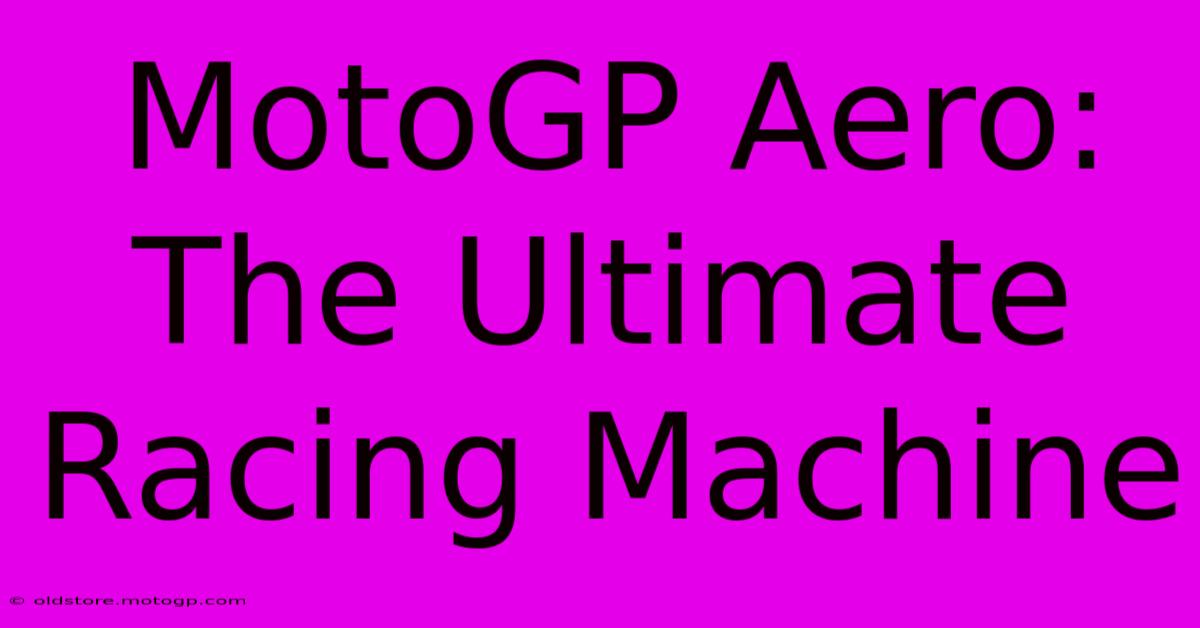MotoGP Aero: The Ultimate Racing Machine

Table of Contents
MotoGP Aero: The Ultimate Racing Machine
MotoGP. The pinnacle of motorcycle racing. Speeds exceeding 200 mph, razor-sharp cornering, and breathtaking overtakes define this thrilling spectacle. But behind the raw power and incredible skill of the riders lies a crucial element often overlooked: aerodynamics. MotoGP aero isn't just about looking cool; it's the key to unlocking lap times and winning races. This article delves deep into the science and strategy behind the aerodynamic marvels that dominate the MotoGP grid.
Understanding the Importance of Aerodynamics in MotoGP
At these breakneck speeds, even minor aerodynamic inefficiencies translate into significant time losses. The aerodynamic forces acting on a MotoGP bike – drag, downforce, and lift – directly impact its performance. Drag resists forward motion, slowing the bike down. Downforce pushes the bike towards the track, improving stability and cornering speeds. Lift, on the other hand, can destabilize the bike, especially at high speeds.
The goal of MotoGP aero development is to maximize downforce while minimizing drag. This delicate balance is crucial for achieving optimal performance.
The Key Components of MotoGP Aerodynamics
Modern MotoGP bikes are festooned with intricate aerodynamic devices designed to achieve this balance. These include:
-
Winglets: These small wings, positioned on the fairing, generate downforce, improving stability through corners and under braking. Their precise design and placement are critical, affecting both downforce and drag.
-
Fairings: The entire bodywork of the bike is meticulously sculpted to manage airflow. Computational Fluid Dynamics (CFD) simulations play a crucial role in optimizing fairing design for minimal drag and maximum downforce.
-
Wings: Larger wings, often found on the rear of the bike, contribute significantly to downforce, particularly on high-speed straights and exiting corners. However, they also increase drag, requiring careful optimization.
-
Underbody Aerodynamics: The design of the underbody is equally important, shaping airflow beneath the bike to generate ground effect – a phenomenon creating suction that further increases downforce.
-
Bodywork shaping and rider position: The streamlined shape of the bodywork and rider's tuck position are key in reducing drag and improving overall aerodynamics.
The Evolution of MotoGP Aerodynamics
MotoGP aero has undergone a dramatic evolution. Early bikes were relatively simple, with aerodynamics playing a secondary role. However, as speeds increased, the importance of sophisticated aero designs became paramount.
The introduction of winglets marked a significant turning point, leading to a rapid arms race among manufacturers. Each iteration refined designs, pushing the boundaries of aerodynamic efficiency. We've seen significant changes in the size, shape, and positioning of winglets and wings over the years, reflecting the ongoing quest for performance gains.
The Role of Technology in MotoGP Aero Development
Sophisticated computational tools, such as CFD simulations and wind tunnel testing, are integral to modern MotoGP aero development. These technologies allow engineers to test and refine designs virtually before building physical prototypes. This iterative process maximizes efficiency and minimizes the time and cost associated with physical testing.
The Future of MotoGP Aerodynamics
The future of MotoGP aero is likely to involve further refinement of existing technologies and the exploration of new concepts. We can expect to see more sophisticated designs that optimize downforce and drag even further. The constant push for marginal gains means innovation will continue to drive the evolution of MotoGP aero. This relentless pursuit of aerodynamic perfection ensures that MotoGP will continue to be a spectacle of speed, precision and technological prowess.
Keywords: MotoGP, Aerodynamics, Aero, Winglets, Wings, Downforce, Drag, Fairing, MotoGP Bikes, Wind Tunnel, CFD, Motorcycle Racing, Racing Technology, Motorcycling.

Thank you for visiting our website wich cover about MotoGP Aero: The Ultimate Racing Machine. We hope the information provided has been useful to you. Feel free to contact us if you have any questions or need further assistance. See you next time and dont miss to bookmark.
Featured Posts
-
F1 Austin Concert An Unforgettable Soundtrack
Feb 18, 2025
-
Qualifying Results Moto Gp Riders Gear Up For An Epic Race
Feb 18, 2025
-
Circuit Race Injury Prevention Stay Healthy
Feb 18, 2025
-
Mastering The Wind Moto Gp Aerodynamics And Rider Skill
Feb 18, 2025
-
Motorcycle Helmet Safety Checklist Avoid Fake Helmets
Feb 18, 2025
